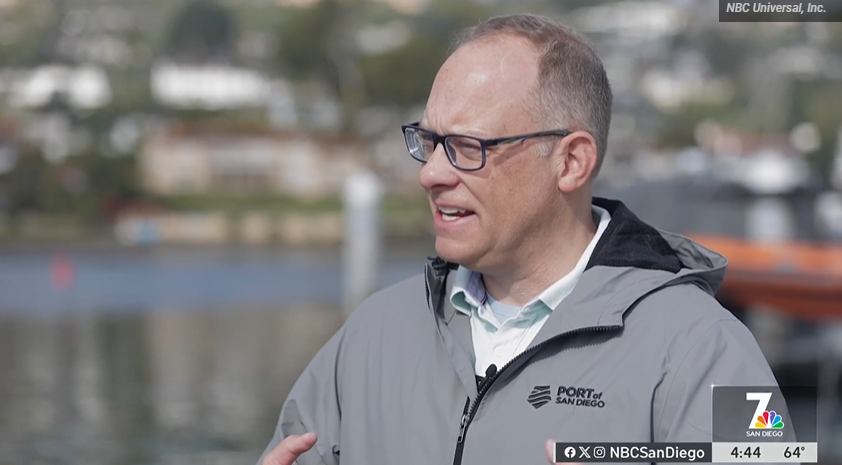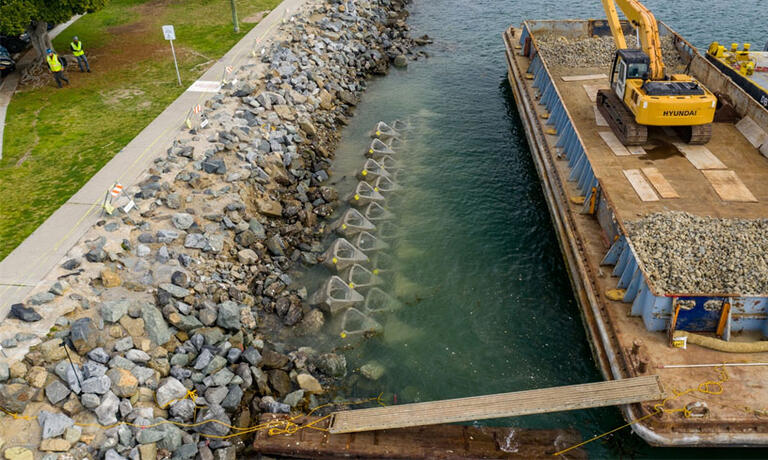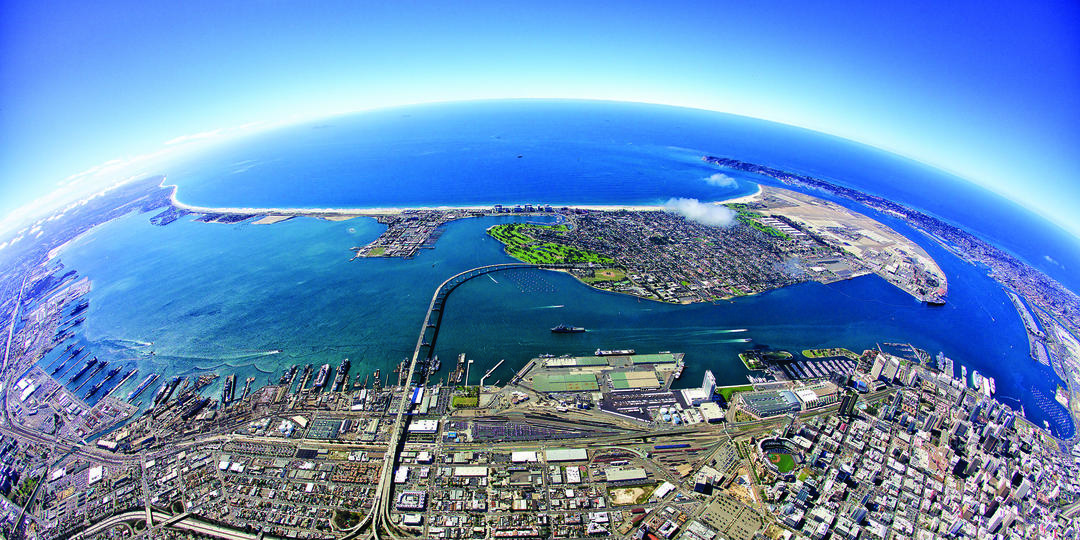Supporting Aquaculture and Blue Technology Innovation
At the Port of San Diego, we recognize the importance of the Blue Economy and the value of our strategic position on San Diego Bay, which is home to a world leading blue technology cluster. That’s why we’re taking an active leadership role in the development of sustainable aquaculture and marine technologies.
Join us as we continue advancing the Blue Economy.
San Diego’s Blue Tech Bay
By supporting entrepreneurship and partnering with innovators through the Blue Economy Incubator (BEI), the Port is bringing new sustainable ocean solutions to San Diego Bay, affirming its reputation as the Blue Tech Bay.
The BEI is the only one of its kind in the world. To date, the Port has supported the launch of 12 innovative pilot projects to inform present and future Blue Economy opportunities. One of the newest additions to the BEI, HyperKelp was highlighted in an NBC7 San Diego news story.

Blue Economy Incubator (BEI)
The Port’s Blue Economy Incubator (BEI) is building a portfolio of businesses and partnerships that deliver multiple social, environmental, and economic benefits to the Port and the region by removing barriers to entrepreneurs and providing funding, key assets, support services including entitlement and permitting assistance, and pilot project facilitation.
Innovation Opportunities
Through its BEI, the Port is seeking to support various innovation opportunities within the blue economy, including:
- Nature Based Solutions
- Coastal Resiliency and Monitoring
- Shellfish and Seaweed Aquaculture
- Environmental Protection and Remediation
- Maritime Decarbonization
- Ocean Data, Monitoring, Sensing, and Security
Pilot Project Facilitation
The success of the BEI is based off its core value proposition of pilot project facilitation, supported by a Port-wide collaboration process.
- Funding
- Port-based testbed and pilot sites
- Pilot project facilitation services
- Regulatory and permitting assistance
- Subject matter expertise
- Access to global network of partners
- Public Relations and media visibility
- Support to leverage grant opportunities
Our Impact In Numbers
35+Partnerships
$2.35millionin funding for pilot projects
$$5.8million in research and development funds leveraged by BEI companies

Active Blue Economy Pilot Projects
-
VoltSafeVoltSafe
VoltSafe is an electrification startup bringing next-generation marina shore power and smart marina technology to San Diego Bay. VoltSafe aims to make the Port’s marinas safer and more efficient with their new shore power system that ditches the traditional pronged plug and replaces it with a magnetic connection. Magnetic technology reduces the risk of electrical shocks, corrosion, and other hazards that come with water and power mixing. The system also comes with smart software that gives marina operators a real-time look at what’s happening at each slip – from power usage and disconnections to leaks and peak demand.
-
MarineLabsMarineLabsSee the latest
MarineLabs is a scale up coastal intelligence company specializing in providing real-time coastal domain awareness and climate resilience data from sensor nodes that can help the Port make informed decisions about its coastal resilience projects and operations.
MarineLabs’ technology will focus on providing persistent wave, wind, and wake data above the water’s surface and complement another BEI company Hyperkelp, whose buoy platforms collect data on underwater noise and water chemistry.
-
Sensor Agnostic Smart Buoys - HyperKelpSensor Agnostic Smart Buoys - HyperKelp
In 2023, the Port partnered with HyperKelp Inc. to demonstrate a sensor agnostic “smart” buoy platform. HyperKelp is an early-stage company specializing in the custom development of smart buoy platforms, known as Kelp Smart Buoy. The buoy platforms can collect and aggregate data in near real-time and display results on an online dashboard. This technology will monitor underwater noise levels, atmospheric carbon dioxide concentrations, and various water quality parameters.
This monitoring technology will help inform and support the development of several Port initiatives including shellfish and seaweed aquaculture planning efforts, environmental protection, conservation, restoration, enhancement, and nature-based solutions projects. It also compliments the Vessel Speed Reduction Program (VSR), which helps reduce maritime emissions, as well as underwater noise, which can provide additional benefits to the marine ecosystem. Reducing maritime emissions is also in alignment with the Port’s Maritime Clean Air Strategy (MCAS).
-
Sustainable Seaweed AquacultureSustainable Seaweed AquacultureDownload Sunken Seaweed Scorecard
Sunken Seaweed, an aquaculture start-up company led by two marine ecologists joined the Port’s BEI to demonstrate the feasibility of seaweed aquaculture in San Diego Bay. Sunken Seaweed established a seaweed hatchery at San Diego State University’s Coastal and Marine Institute Laboratory and installed their submerged pilot farm using assets, such as docks and piers, managed by the Port. The company is successfully cultivating, outplanting, growing, monitoring, and harvesting several species of seaweed native to Southern California. Beyond commercialization, results from the pilot project are helping assess seaweed aquaculture’s multiple co-benefits, from carbon sequestration and bioremediation to improving water quality and ecosystem productivity. In 2022, the Port reinvested in an expansion of Sunken Seaweed's pilot which enables the company to build and continue its research in the burgeoning industry in and around San Diego Bay, while expanding operations to Humbolt Bay where they will benefit from shoreside facilities to help them reach market scale. Sunken Seaweed was recently showcased during a 2023 NBC “Climate Today” series with host and NOAA emissary, Al Roker.
-
Stormwater Monitoring DeviceStormwater Monitoring DeviceDownload FREDsense Technologies Scorecard
The Port approved FREDsense Technologies for a pilot project to develop a portable five-in-one field-testing sensor device to provide real-time metals analysis for stormwater monitoring. FREDsense automatically tests levels of aluminum, copper, lead, zinc, and nickel – all of which are known to enter San Diego Bay through stormwater. The system provides real-time data in the field, which is significantly faster than the several weeks necessary to receive traditional laboratory results, allowing for quicker adjustments to Best Management Practices.
-
Shellfish NurseryShellfish NurseryDownload San Diego Bay Aquaculture Scorecard
San Diego Bay Aquaculture is testing if a shellfish nursery, called a FLUPSY, or Floating Upweller System, can be effective in helping address a coast-wide shellfish seed shortage. The FLUPSY is a floating barge that circulates water through compartments or bins holding shellfish, in this case oysters, as they grow from about the size of a red pepper flake to about the size of a quarter when they are ready to go to the farm. The operation of the FLUPSY, combined with the region’s mild weather and nutrient-rich water, offers a competitive advantage over northern shellfish nursery sites because seed to harvest time is reduced up to one year compared to northern locations. After being in the FLUPSY, shellfish will be transported to a farm where it will grow to market size. Approvals to conduct this pilot have been slow to obtain, but San Diego Bay Aquaculture is using the FLUPSY to conduct much needed research for oysters, abalone, and seaweeds, and production is expected to begin this year (2023). The FLUPSY is being more widely recognized after being showcased during a 2023 NBC “Climate Today” series with host and NOAA emissary, Al Roker.
Advancing Aquaculture in and around San Diego Bay
Our focus on shellfish and seaweed aquaculture opens the door to future sustainable commercial opportunities in multiple areas, including food production, biofuel, bioplastics, and other alternative materials. When thoughtfully planned, managed, and operated, shellfish and seaweed aquaculture can co-exist with other maritime functions and provide many benefits such as improving water quality, habitat enhancement, carbon sequestration, and ecosystem restoration.
With San Diego Bay and its surrounding environment’s natural characteristics to support shellfish and seaweed aquaculture, the Port has the potential to grow a new industry sector, create jobs, and bring additional economic and environmental benefits to the region.
